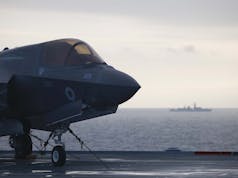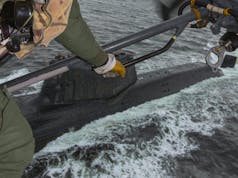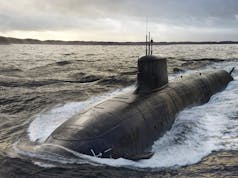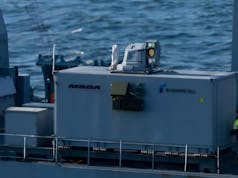Britain’s Carrier Strike Group, currently deployed to the Indo-Pacific under Operation Highmast, has conducted a high-intensity barrier operation exercise designed to ‘fight off’ an intruding warship attempting to close on a British aircraft carrier.
According to Lieutenant Commander Grayson, officer in charge of the operations room aboard HMS Prince of Wales, the scenario tested the group’s ability to react swiftly and decisively to a hostile surface contact.
“We’re effectively exercising an intruder ship trying to close the task group and close the carrier,” Grayson explained. “At which point we direct one of our escorts to put themselves in the way and then create a physical barrier against that ship.”
Last week’s drill saw Royal Navy Type 23 frigate HMS Richmond and Royal New Zealand Navy frigate HMNZS Te Kaha performing aggressive manoeuvres to intercept and block the simulated adversary. “Some really good, aggressive driving from Te Kaha and from Richmond, which is really good to see,” Grayson noted.
UK #CSG25 led by @HMSPWLS conducting Barrier Operation Drills last week with @NZNavy #OpHighmast pic.twitter.com/5KpDsdbMvz
— UK Carrier Strike Group (@COMUKCSG) July 14, 2025
The aim of such barrier drills is to train escort ships to react automatically under pressure. “We just train it again and again with our escorts so that everyone knows immediately and instinctively what they need to do if the situation arises and we give that order,” Grayson said.
The exercise is part of a broader emphasis on improving interoperability with allied navies. “This is a chance for us to conduct an exercise with our escorts, both from the UK and from our international allies,” he said.
Grayson underlined the importance of working with regional partners when operating in waters far from home. “Not somewhere we come a lot to with our larger vessels,” he acknowledged. “So we operate with partners who, number one, operate here a lot more regularly than we do, number two, have different equipment, different systems and sometimes different tactics.”
By cross-training in these environments, CSG25 aims to expand its tactical repertoire and develop shared operational instincts with Indo-Pacific allies. “By working together across those environments, we can improve our own capabilities and our ability to operate at range,” Grayson concluded.
The purpose
Operation Highmast is the codename for the United Kingdom’s 2025 global deployment of Carrier Strike Group 25, launched in April and centred on HMS Prince of Wales. The deployment is intended to project British maritime and air power across the Indo-Pacific, reinforce strategic partnerships, and support freedom of navigation operations in contested regions.
Sailing from Portsmouth through the Mediterranean, Red Sea, and Indian Ocean into the Pacific, the group engages in a range of high-end exercises with NATO and regional allies.
The carrier is accompanied by a mix of escorts and support vessels drawn from the Royal Navy and partner nations, including Canada, Norway, Spain, and Sweden. These international contributions enhance operational reach, provide layered defence, and embed allied personnel into the UK-led command structure. In total, around 4,500 personnel are involved over the course of the deployment, including members of the Royal Navy, Royal Air Force, British Army, and allied armed forces.
A core feature of Operation Highmast is the carrier’s air wing, which began the deployment with 18 F-35B Lightning II jets and is expected to scale up to 24. This is the largest number of F-35s ever deployed at sea. Sadly, one aircraft was forced to divert and land in India due to a hydraulic failure, it is however now being recovered. The air wing includes aircraft from both RAF and Royal Navy squadrons, supported by helicopters for anti-submarine warfare and airborne early warning tasks.
In addition to traditional naval operations, the deployment emphasises cyber defence and resilience to asymmetric threats. A dedicated UK-based cyber team supports the force during its transit through regions of elevated risk, defending against frequent intrusion attempts.
The strike group is conducting a series of complex multinational drills involving carrier strike operations, submarine tracking, counter-drone scenarios, and integrated air defence. Key exercises include Neptune Strike and Talisman Sabre, reflecting the UK’s intent to contribute credible, persistent presence to Indo-Pacific security.














What a headline, had me going for a second. Really driving for those clicks
agreed
I would say boat swarms are more concerning.
And they train for that scenario too.
Mention now of the F35 recovery, is this being taken back to Marham or is it rejoining the CSG?
Marham.
Remind me how many warships the PLAN have and if it took two to divert one ‘aggressor’ how many ships are sailing in formation with PoW?
PoW being sunk once in the South China Sea is bad luck, being sunk twice is just foolish.
Not our problem, stay clear, and let others ‘acker up for their own security.
We need our forces to defend the UK and should the Commonwealth come under attack, be able to sortie to meet that threat and help defend the Commonwealth; that’s not today.
The shear lack of self defensive armaments on these carriers makes me cringe. With all the T23s coming out of service you’d think there’d be a lot of spare 30mm, decoy launchers that could be repurposed on both carriers. Plus all their CAMM!? Hopefully they’re getting recycled!
There is nowhere to put the CAMm, also T26 is using those,
30mm mounts are being used for other systems like torpedo decoys, not like they add to the missile defence anyway.
There are spots. Forward-side, on a built out flange, mid way behind the Phalanx and on the rear sponson, all on the starboard side. Maybe 2 Exls will do the trick or if the 6 silo pack 4-8×6 spread out. Sponsons can be strengthened and built out and up. Might be best to leave front, port, rear clear for ops.
Every other carrier operator finds spots for their systems.
Or modify the RAM launcher to take Martlet ER or Asraam?
No, there isn’t.
You’re just hoping they can cram it onto there without knowing anything else apart from eyeballing it.
Most other carriers are made with space for it from the get go.
And who is paying to modify a RAM launcher for our niche missiles exactly?
Come on NZ, get some NSM’s on those Anzac’s! 2 sets won’t break the NZ defence budget!
But it would be a monumental waste of money.
If when the Chinese navy passes by your shores you’ll think differently. 2×4 or even 2×2 NSM for the two frigates rather than just a 5″ and pair of Penguin ashms on an old Seasprite. They haven’t ordered any ashms for their P8s at the moment and have not subs or large drones. NSM is also made in Aust so NZ might get a good price.
Why would a warship try to get closer? To ram??
Isn’t it causing its own destruction?
Wouldn’t an adversary just fire hundreds of ASM from aircraft instead?
I read the headline and assumed a Chinese vessel snooping around.
For one thing, making operations difficult while not at war, like the Russians did in the Eastern Med during CSG21. Most likely also some intelligence gathering. Their behaviour was definitely hostile. It has been shown in “The Warship: Tour of Duty.” I think they’ve learned a thing or two from that experience, making it part of an exercise seems a sensible thing to do.
This is a standard close protection vehicle drill—positioning the Personal Escort Section (PES) vehicle between the VIP vehicle and any potential threat. It’s a sound tactic, particularly in hostile environments where the threat of VBIEDs is significant. For example, British Army Close Protection Unit (CPU) teams operating in Iraq and Afghanistan typically did not have top cover, as they primarily used Land Cruisers or G-Wagons, which lacked the capability to engage threats while on the move.
I’m with DM — I don’t quite understand how this drill would apply to ships. Surely, after escalating the appropriate warnings, the threat would be neutralised, either deterred, disabled, or sunk.
I’m sure there are people here with direct experience of this drill in a maritime context, so any insights would be appreciated 👍
Yep. I’m curious to see replies.
Makes sense for a submarine to close in, but a warship?
Unless it’s replicating the Yamato on a suicide mission?
I was thinking more along the lines of what would happen if Greenpeace were to escalate and get too close to an aircraft carrier. Even in that scenario, I still think the best option for everyone involved would be to sink their ship. 👍
On a serious note, I understand they’re training for an ‘intruding warship’, so someone must know the reasoning behind this.
No, that’s a good point. The usual idiots.
The warship is playing the part of the “hostile surface contact” so take ones pick.
Sadly there is always, if you know where to look, someone willing to meet their maker for a cause.
Trying to fight the battle of the Atlantic or midway again
Even Soviet doctrine didn’t work like that
A surface contact would be a drone carrier to overwhelm the fleet in conjunction with an air threat and underwater one
The RAN kept.sinking US carriers with full fleet support using just Collins class diesel subs
What suddenly makes us so special.
It’s a good job there are no real enemies out there because we can’t even deal with the ones we make for ourselves.